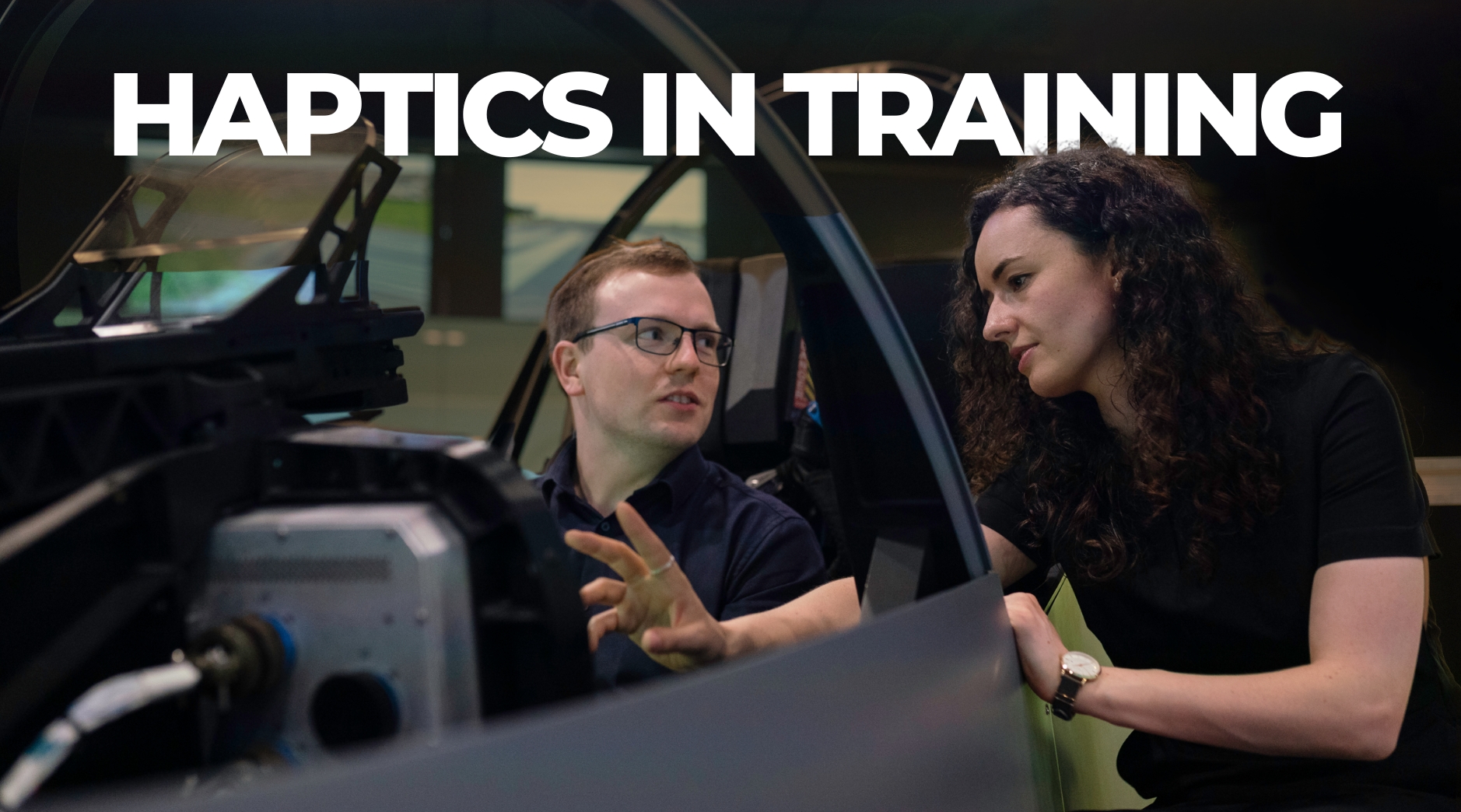How Haptics & Hardware Improve Simulation-Based Training
 Magnimus
Magnimus
In recent years, simulation-based training has transformed industries ranging from automotive, healthcare, defense, aviation, and heavy machinery. But what makes these simulations truly effective? The answer lies in haptic feedback and advanced hardware integration, which bring a new level of realism and immersion to virtual training.
By incorporating haptic technology (which simulates touch sensations) and motion platforms (which recreate real-world movement), training programs become more engaging, effective, and safe. This blog explores how haptics and hardware improve simulation-based training, their applications across industries, and the future of immersive learning.
What is Haptic Technology in Simulation-Based Training?
Haptic technology enables users to "feel" digital environments through vibrations, forces, and motions. It replicates real-world physical sensations, making virtual experiences more immersive.
How Does Haptic Feedback Work?
Haptic systems use force feedback actuators and pressure sensors to create realistic sensations, allowing users to:
✔ Feel resistance when pressing buttons, pulling levers, or gripping objects
✔ Experience different textures, surfaces, and materials in a virtual setting
✔ Receive impact feedback when interacting with a simulated environment
In training simulations, haptic feedback helps learners develop muscle memory and reflexive responses, preparing them for real-world tasks more efficiently.
Role of Motion & Hardware in Simulation-Based Training
While haptics enhances touch, motion platforms bring dynamic movement into training simulations. These platforms replicate realistic physical forces such as acceleration, braking, impact, and tilting, creating a multi-sensory learning experience.
Examples of Hardware-Driven Motion Platforms
🔹 Sanlab SLINE 3DOF Motion Simulator: This system provides three degrees of freedom (DOF)—pitch, roll, and heave—recreating a true-to-life driving experience for automotive trainees. (Sanlab)
🔹 YHY Racing Pro Simulator: Designed for racing professionals, it integrates high-precision force feedback steering, pedals, and haptic seat movements, ensuring real-time tactile response and driver adaptability. (YHY Simulator)
🔹 Tecknotrove Driving Simulators: These solutions are used for automotive and commercial driver training, providing realistic road conditions, force feedback, and environmental effects to improve driver safety and decision-making. (Tecknotrove)
These systems enable practical, immersive training that would otherwise be too costly, unsafe, or impractical in real-life scenarios.
How Haptics & Motion Improve Training Outcomes
1. Increased Training Realism
Simulation-based training reduces the gap between theory and practice. Haptic and motion feedback create a near-realistic environment, allowing trainees to:
✔ Feel road grip, braking resistance, and acceleration in driving simulators
✔ Experience engine vibrations and impact forces in industrial training
✔ Engage in realistic physical movements in VR-based medical or defense training
2. Faster Skill Development & Muscle Memory
Repetitive physical interaction with a simulation helps trainees build muscle memory for real-world application. This is particularly useful for:
✔ Pilots practicing flight maneuvers in motion-enabled cockpits
✔ Surgeons training on robotic surgical simulators with haptic precision tools
✔ Drivers developing reflexes for emergency scenarios
3. Reduced Training Risks & Costs
Haptic and motion simulations allow learners to practice high-risk tasks in a safe environment:
✔ Pilots can train for emergency landings without real-world risk
✔ Industrial workers can practice handling heavy machinery before operating real equipment
✔ Firefighters and military personnel can train for crisis situations in controlled virtual environments
This reduces liability, workplace accidents, and operational costs, making it a cost-effective training alternative.
Industry-Specific Applications of Haptic & Hardware Training
Automotive & Transportation
Driver Training Simulators: Replicate real-road conditions with motion-based steering and pedal feedback.
Racing Simulators: Provide professional racers with precision steering, force feedback, and track realism.
Forklift & Heavy Vehicle Training: Allow operators to practice in a risk-free, virtual warehouse or construction site.
Aviation & Aerospace
Pilot Training: Motion-enabled cockpit simulators train pilots in turbulence handling and emergency scenarios.
Aircraft Maintenance: Technicians use haptic tools to simulate part replacements and repairs.
Manufacturing & Industrial Training
Machinery & Equipment Training: Workers practice operating complex machines in a digital twin environment.
Welding & Assembly Simulations: Haptic gloves help trainees feel resistance and simulate hand precision.
Healthcare & Medical Training
Surgical Simulations: Haptic-enabled robotic surgery training improves precision.
Physical Therapy & Rehabilitation: Patients use motion platforms for virtual physiotherapy and mobility training.
Defense & Law Enforcement
Combat & Tactical Training: Soldiers experience recoil feedback and impact forces in VR combat simulations.
Virtual Reality Firearms Training: Helps law enforcement develop real-world situational awareness.
Each industry benefits from realistic, immersive, and interactive training environments that enhance safety, efficiency, and skill development.
Know more: https://www.magnimus.com/industrial-solutions
Future Trends in Haptic & Hardware Simulation Training
The future of simulation-based training is advancing rapidly, with new developments shaping immersive learning:
🔹 Full-Body Haptic Suits: Providing real-time sensory feedback across the body, increasing realism in tactical and physical training.
🔹 AI-Integrated Haptics: Machine learning algorithms analyze trainee behavior and adapt simulations for personalized training experiences.
🔹 Wireless & Wearable Haptic Devices: Compact, lightweight haptic gloves and exoskeletons allow for natural interaction in virtual environments.
🔹 4D Motion Simulations: Future multi-axis motion platforms will replicate even more realistic terrain conditions.
These innovations will make simulation-based training even more immersive, accessible, and scalable for industries worldwide.
Transform Your Workforce Training with Magnimus
At Magnimus, we specialize in next-generation simulation-based training solutions powered by haptic technology, VR, and AI-driven learning. Our immersive training modules help industries train faster, safer, and more effectively.
What We Offer:
🔹Realistic VR/AR Simulations – Hands-on training experiences with real-world physics & interactions
🔹Haptic-Enhanced Learning – Feel resistance, impact, and textures for precise skill-building
🔹Motion Platform Integration – Multi-axis systems for dynamic, high-accuracy simulations
🔹AI-Powered Personalization – Adaptive learning paths based on user performance
Industries We Serve:
🔹 Manufacturing & OEMs – Safe, scalable machine training solutions
🔹 Automotive & Transportation – Driving & racing simulations for enhanced reflex development
🔹 Healthcare & Medical Training – Precision surgical simulations with haptic feedback
🔹 Defense & Tactical Training – Real-world combat and firearms simulations
Why Choose Magnimus?
✔ Cost-Effective & Scalable – Reduce training costs while improving efficiency
✔ Multi-Platform Accessibility – No need for expensive hardware installations
✔ High-Impact Workforce Development – Train employees faster & retain talent better
The future of training is immersive, adaptive, and data-driven. Are you ready to level up your workforce?Contact us today for a free consultation!
#VRTraining #SimulationTech #Haptics #AIinTraining #WorkforceDevelopment #Magnimus
Conclusion: Why Haptics & Hardware Are Essential for Next-Gen Training
Haptics and hardware integration have redefined simulation-based training, making it more immersive, engaging, and effective. By using motion-enabled systems, force feedback tools, and VR-based simulations, industries can:
🔹 Improve training realism and engagement
🔹 Accelerate skill development and retention
🔹 Reduce training costs and risks
🔹 Enhance workforce readiness for real-world challenges
At Magnimus, we specialize in developing advanced immersive training solutions using VR, AI, and haptics to help businesses revolutionize workforce training.
🚀 The future of training is here—are you ready to embrace it?
📩 Contact us to learn how haptics & immersive simulations can enhance training for your industry.
🔎 Related Reads & Sources
🔗 YHY Racing Pro Simulator 🔗Sanlab 3DOF Motion Simulator 🔗Tecknotrove Driver Training Services
Subscribe to my newsletter
Read articles from Magnimus directly inside your inbox. Subscribe to the newsletter, and don't miss out.
Written by
